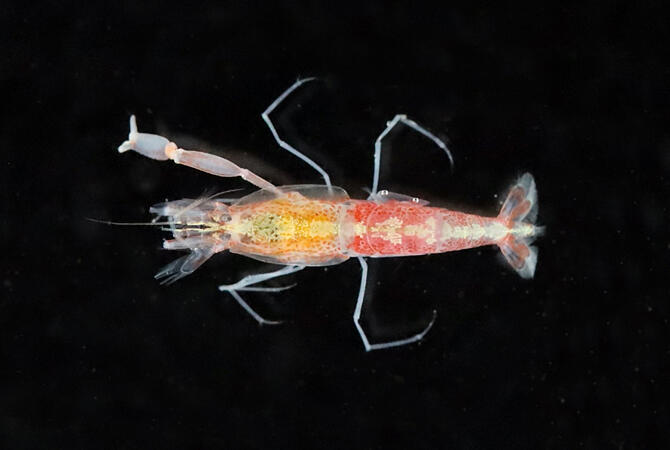Alpheid shrimps are crustaceans belonging to the family Alpheidae, order Decapoda, found in brackish water on the seafloor in the bathypelagic zone. Among alpheid shrimps, the genus Athanas, which includes 41 species from the Indo-West and East Pacific and 12 species from Japan, is a highly diverse group that includes free-living species, sea urchin symbionts, and species that coexist in burrows with other large crustaceans, such as mantis shrimp and giant clams. The group has a high degree of ecological diversity.
A joint research group led by Tomoyuki Komai, Head of the Zoology Division at the National History Museum and Institute, Chiba, and Assistant Professor Yumi Henmi of the Field Science Education and Research Center at Kyoto University discovered an undescribed crustacean on the seafloor off Ine-cho, Yosa-gun, in Kyoto Prefecture and described it as a new species of alpheid shrimp, Athanas exilis. The discovery has been published in the online version of the journal Zootaxa.

Provided by Kyoto University
The shrimp was discovered in mud collected from Wakasa Bay at a depth of 90 m by the research vessel Ryokuyo Maru of the Maizuru Fisheries Research Station. The collected shrimp is a small species, about 10 mm in length, and was identified as an undescribed species of the genus Athanas mainly based on differences in the characteristics of the antennae and the shape of the telson. In addition to the morphology analysis, they obtained a partial sequence of the mitochondrial 16S rRNA gene.
Because of the elongated phalanges on the third through fifth thoracic legs, the new species, Athanas exilis, was named using the Latin word "exilis" meaning "elongated." The shrimp was named "Wakasa purple shrimp" because it was collected from Wakasa Bay. Only one egg-bearing female shrimp was collected during a one-year periodic survey, suggesting a small population. They aim to collect more individuals, including males, in future surveys.
This is the second recent report on discovering a new species from the seas of Kyoto Prefecture, following the description of the Wakasa ghost shrimp last year. Henmi commented, "After the recent discovery of the ghost shrimp in Wakasa Bay, it is now the Wakasa purple shrimp's time to shine. Please stay tuned for the next creature to appear,"
It is believed that there is unknown biodiversity of shrimp in the Sea of Japan, and future research is planned to elucidate the biota and improve knowledge about their diversification.
Komai also commented, "We are surprised to find one new species after another from the Sea of Japan. Continuous research is important." Adding, "We must also do our best on the Pacific side." The research group will continue to promote research in Wakasa Bay using the Ryokuyo Maru of the Maizuru Fisheries Research Station.
This article has been translated by JST with permission from The Science News Ltd. (https://sci-news.co.jp/). Unauthorized reproduction of the article and photographs is prohibited.




